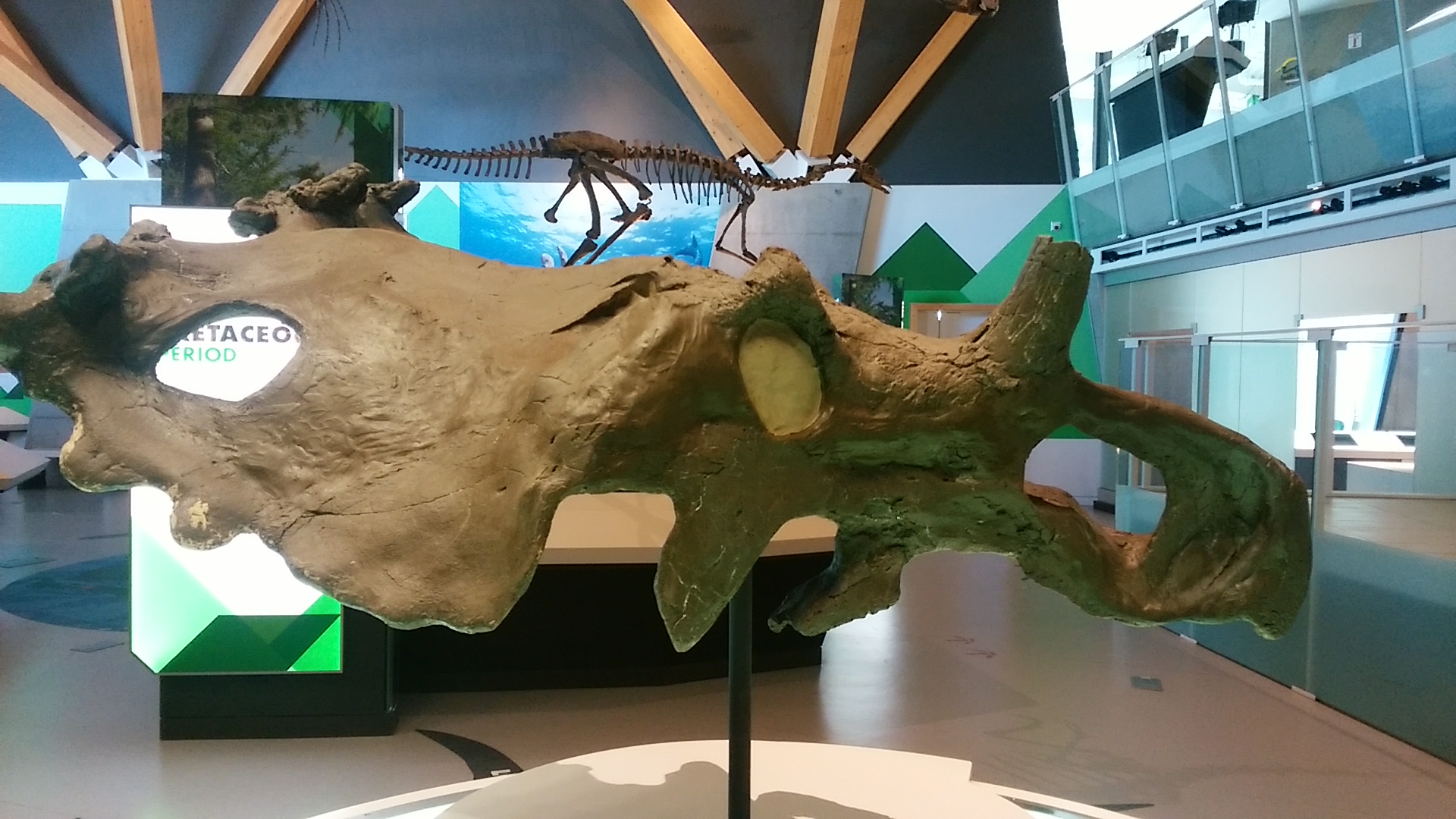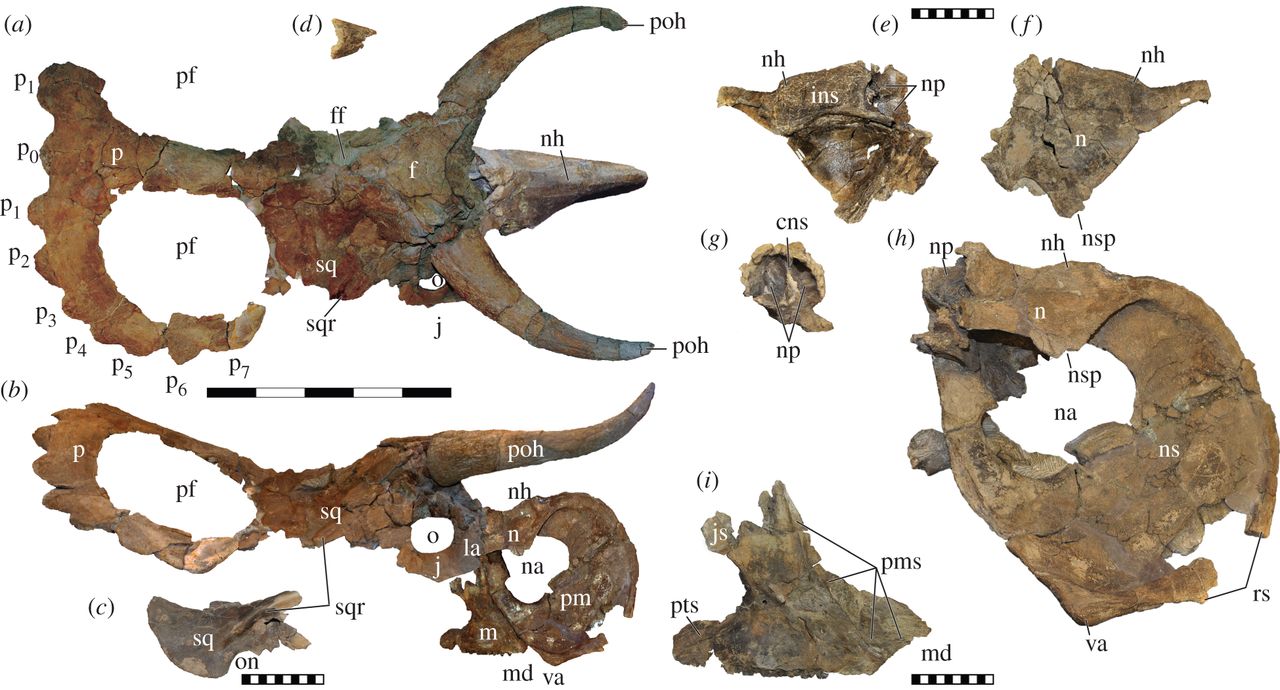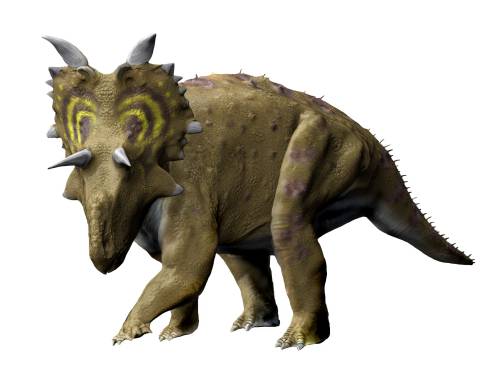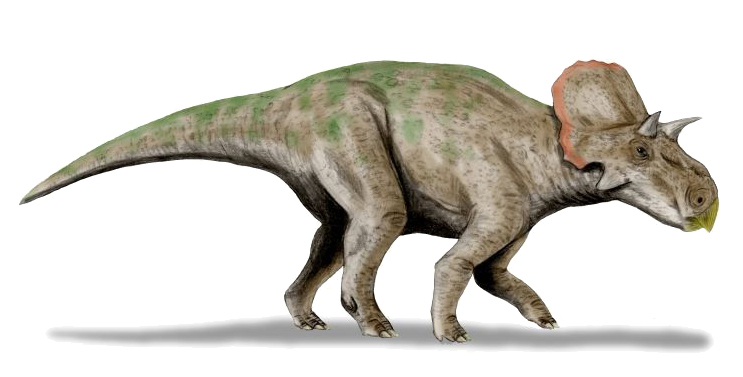|
Centrosaurini
Centrosaurinae (from the Greek language, Greek, meaning "pointed lizards") is a subfamily of ceratopsid dinosaurs, a group of large quadrupedal Ornithischia, ornithischians. Centrosaurine fossil remains are known primarily from the northern region of Laramidia (modern day Alberta, Montana, and Alaska) but isolated taxa have been found in China and Utah as well. Defining features of centrosaurines include a large nasal horn, short supratemporal horns, and an ornamented frill projecting from the back of the skull. With the exception of ''Centrosaurus, Centrosaurus apertus'', all adult centrosaurines have spike-like ornaments midway up the skull. Morphometric analysis shows that centrosaurines differ from other ceratopsian groups in skull, snout, and frill shapes. There is evidence to suggest that male centrosaurines had an extended period of adolescence, and sexual Biological ornament, ornamentation did not appear until adulthood. Centrosaurinae was named by paleontologist Lawrence ... [...More Info...] [...Related Items...] OR: [Wikipedia] [Google] [Baidu] |
Pachyrhinosaurini
Pachyrhinosaurini is a tribe (biology), tribe of Centrosaurinae, centrosaurine dinosaurs. The clade existed during the Late Cretaceous, about 84.9 to 68.5 million years ago, evolving during the earliest Campanian, and becoming extinct in the Maastrichtian. The tribe contains three genera: ''Einiosaurus'', ''Achelousaurus'', and ''Pachyrhinosaurus''. ''Pachyrhinosaurus'' and ''Achelousaurus'' form the clade of pachyrhinosaurins called the Pachyrostra ("thick-snouts"), characterized primarily by their nasal bosses. Classification Pachyrhinosaurini was defined in 2012 by Fiorillo & Tykoski. It was defined as all centrosaurine ceratopsids more closely related to ''Pachyrhinosaurus canadensis'' than to ''Centrosaurus apertus''. It was defined during the description of ''Pachyrhinosaurus perotorum'', a species from Alaska. The cladogram below represents the findings of Lund et al., 2016, in their description of ''Machairoceratops cronusi''. ''Wendiceratops pinhornensis'', ''X ... [...More Info...] [...Related Items...] OR: [Wikipedia] [Google] [Baidu] |
Coronosaurus
''Coronosaurus'' is a genus of centrosaurine ceratopsian dinosaurs which lived in the Late Cretaceous, in the middle Campanian stage. Its remains, two bone beds, were discovered by Phillip J. Currie in the Oldman Formation of Alberta, Canada, and its type and only species, ''Coronosaurus brinkmani'', was first described in 2005, as a new species within the genus ''Centrosaurus''. Later studies questioned the presence of a direct relationship, and in 2012 it was named as a separate genus. ''Coronosaurus'' means "crowned lizard", coming from "''corona''", Latin for crown, and "''sauros''", Greek for lizard; this name refers to the unique, crown-like shape of the horns on the top of its frill. Like other ceratopsids, ''Coronosaurus'' had a large frill and horns on its head. These include a small pair of brow horns over its eyes, a large nasal horn on its snout, and, unique among ceratopsians, irregular, spiky bone masses on its frill. Growing up to around long and in weight, it wa ... [...More Info...] [...Related Items...] OR: [Wikipedia] [Google] [Baidu] |
Machairoceratops
''Machairoceratops'' (meaning "bent sword horned face"), previously known as the "Wahweap centrosaurine B", is an extinct genus of centrosaurine ceratopsian dinosaur known from the Late Cretaceous Wahweap Formation (late Campanian stage) of Grand Staircase–Escalante National Monument, southern Utah, United States. Discovery It contains a single species, ''M. cronusi'', first described and named in 2016 by Eric K. Lund, Patrick M. O’Connor, Mark A. Loewen and Zubair A. Jinnah. The generic name is derived from Greek ''machairis'', meaning "bent sword", in reference to its unique frill ornamentation showing two forward curving horns on the frill's uppermost part, and Latinized Greek ''ceratops'', meaning "horned-face", which is a common suffix for ceratopsian genera names. The specific name ''cronusi'' refers to Cronus, a Greek god who deposed his father Uranus by castrating him with a sickle or scythe based on the mythology, and as such is shown carrying a curved bladed wea ... [...More Info...] [...Related Items...] OR: [Wikipedia] [Google] [Baidu] |
Medusaceratops
''Medusaceratops'' is an extinct genus of centrosaurine ceratopsian dinosaur known from the Late Cretaceous Judith River Formation (middle Campanian stage) of Montana, northern United States. It contains a single species, ''Medusaceratops lokii''.Ryan, Michael J.; Russell, Anthony P., and Hartman, Scott. (2010). "A New Chasmosaurine Ceratopsid from the Judith River Formation, Montana", In: Michael J. Ryan, Brenda J. Chinnery-Allgeier, and David A. Eberth (eds), ''New Perspectives on Horned Dinosaurs: The Royal Tyrrell Museum Ceratopsian Symposium'', Indiana University Press, 656 pp. . Discovery The known material of ''Medusaceratops'' came from a bonebed in the badlands on the west side of Kennedy Coulee adjacent to the Milk River, in the Milk River Natural Area, near Havre, Hill County of Montana. The material was first reported by Sweeney and Boyden (1993), who considered it to represent the southernmost occurrence of ''Styracosaurus albertensis'', based on misidentified f ... [...More Info...] [...Related Items...] OR: [Wikipedia] [Google] [Baidu] |
Nasutoceratops
''Nasutoceratops'' is an extinct genus of ceratopsian dinosaur. It is a basal centrosaurine which lived during the Late Cretaceous Period (late Campanian, about 76.0-75.5 Ma). Fossils have been found in southern Utah, United States. ''Nasutoceratops'' was a large, ground-dwelling, quadrupedal herbivore with a short snout and unique rounded horns above its eyes that have been likened to those of modern cattle. Extending almost to the tip of its snout, these horns are the longest of all the members of the centrosaurine subfamily. The presence of pneumatic elements in the nasal bones of ''Nasutoceratops'' are a unique trait and are unknown in any other ceratopsid. Discovery and naming ''Nasutoceratops'' is known from the holotype UMNH VP 16800, a partially associated nearly complete skull, a coronoid process, a syncervical, three partial anterior dorsal vertebrae, a shoulder girdle, an associated left forelimb, parts of the right forelimb and skin impressions. Two spec ... [...More Info...] [...Related Items...] OR: [Wikipedia] [Google] [Baidu] |
Xenoceratops
''Xenoceratops'' (meaning "alien horned face") is a genus of centrosaurine ceratopsid dinosaur known from the Late Cretaceous (middle Campanian stage), and is known to have lived in what is currently Alberta, Canada. The genus has one known species, ''Xenoceratops foremostensis''. Its remains were discovered in the Foremost Formation. Discovery In 1958, Wann Langston, Jr. excavated skull fragments from the Foremost Formation near Foremost, Alberta. The formation is very poorly understood in regards to dinosaur fauna; aside from teeth, only hadrosaur skeletons and the pachycephalosaurid '' Colepiocephale'' have been reported. Langston stored the fragments in cabinets at the Canadian Museum of Nature in Ottawa. Around 2003, David C. Evans and Michael J. Ryan became curious about the specimens, and more thorough investigation was conducted in 2009. They discovered it to be a new species and genus, and it was described in 2012 by Ryan, Evans, and Kieran M. Shepherd. At the time of d ... [...More Info...] [...Related Items...] OR: [Wikipedia] [Google] [Baidu] |
Styracosaurus
''Styracosaurus'' ( ; meaning "spiked lizard" from the Ancient Greek / "spike at the butt-end of a spear-shaft" and / "lizard") is a genus of herbivorous ceratopsian dinosaur from the Cretaceous Period (Campanian stage), about 75.5 to 74.5 million years ago. It had four to six long parietal spikes extending from its neck frill, a smaller jugal horn on each of its cheeks, and a single horn protruding from its nose, which may have been up to long and wide. The function or functions of the horns and frills have been debated for many years. ''Styracosaurus'' was a relatively large dinosaur, reaching lengths of and weighing about . It stood about tall. ''Styracosaurus'' possessed four short legs and a bulky body. Its tail was rather short. The skull had a beak and shearing cheek teeth arranged in continuous dental batteries, suggesting that the animal sliced up plants. Like other ceratopsians, this dinosaur may have been a herd animal, travelling in large groups, as sugges ... [...More Info...] [...Related Items...] OR: [Wikipedia] [Google] [Baidu] |
Spinops
''Spinops'' is an extinct genus of centrosaurine ceratopsian dinosaur from the Late Cretaceous of Alberta, southern Canada. It was a medium-sized ceratopsian, reaching in length and in body mass. Discovery and naming ''Spinops'' is known from the holotype NHMUK R16307, a partial parietal bone, preserving most of the midline bar. Referred material include NHMUK R16308, a partial parietal bone, partial dentary and unidentifiable limb fragments, NHMUK R16306, an incomplete skull, preserving only the dorsal portion of the skull, and NHMUK R16309, a partial right squamosal. None of this material was found in articulation, however it was all closely associated in the same bone bed, in the northwestern region ("Steveville Badlands") of the Dinosaur Provincial Park. Fossils of ''Spinops'' were first found in 1916, and were housed in the Natural History Museum in London. The material was not described until 2011, when the new species ''Spinops sternbergorum'' was ... [...More Info...] [...Related Items...] OR: [Wikipedia] [Google] [Baidu] |
Centrosaurus
''Centrosaurus'' ( ; ) is a genus of herbivorous ceratopsian dinosaur from the Late Cretaceous of Canada. Their remains have been found in the Dinosaur Park Formation, dating from 76.5 to 75.5 million years ago. Discovery and naming The first ''Centrosaurus'' remains were discovered and named by paleontologist Lawrence Lambe in strata along the Red Deer River in Alberta, Canada. The name ''Centrosaurus'' means "pointed lizard" (from Greek ', , "point or prickle" and ', , "lizard"), and refers to the series of small hornlets placed along the margin of their frills, not to the nasal horns (which were unknown when the dinosaur was named). The genus is not to be confused with the stegosaur ''Kentrosaurus'', the name of which is derived from the same Greek word. Later, vast bonebeds of ''Centrosaurus'' were found in Dinosaur Provincial Park, also in Alberta. Some of these beds extend for hundreds of meters and contain thousands of individuals of all ages and all levels of complet ... [...More Info...] [...Related Items...] OR: [Wikipedia] [Google] [Baidu] |
Crittendenceratops
''Crittendenceratops'' (meaning "horned face from the Fort Crittenden Formation") is a genus of horned centrosaurine ceratopsid dinosaur from the late Campanian Fort Crittenden Formation of Arizona. It contains a single species, ''C. krzyzanowskii'', and represents the first species of dinosaur from the Fort Crittenden Formation The Fort Crittenden Formation is a geological formation in Arizona whose strata date back to the Late Cretaceous. Dinosaur remains are among the fossils that have been recovered from the formation.Weishampel, David B; et al. (2004). "Dinosaur dis ... to receive a formal scientific name. Description ''Crittendenceratops'' is distinguished by forward-curving, hook-like flanges located along the central portion of the top of the frill, "extensive" Ceratopsia#Anatomy, epiparietals located along the sides of the parietal bone, parietal portion of the frill, a thickening of the frill in the parietal portion, and a short, pronounced ridge on the surface of th ... [...More Info...] [...Related Items...] OR: [Wikipedia] [Google] [Baidu] |
Avaceratops
''Avaceratops'' is a genus of small herbivorous ceratopsian dinosaurs which lived during the late Campanian during the Late Cretaceous Period in what are now the Northwest United States. Most fossils come from the Judith River Formation. Discovery and naming The first remains of ''Avaceratops'' were found by fossil dealer Eddie Cole in the Judith River Formation of Montana, in 1981, on land of the Careless Creek Ranch, owned by rancher Arthur J. Lammers."Avaceratops." In: Dodson, Peter & Britt, Brooks & Carpenter, Kenneth & Forster, Catherine A. & Gillette, David D. & Norell, Mark A. & Olshevsky, George & Parrish, J. Michael & Weishampel, David B. ''The Age of Dinosaurs''. Publications International, LTD. p. 129. . They were preserved scattered throughout the remains of a prehistoric stream bed. This ''Avaceratops'' specimen was likely buried in the sandbar after its body was swept downstream by the current. The finds, displayed in Cole's fossil shop, were in October 1981 inspect ... [...More Info...] [...Related Items...] OR: [Wikipedia] [Google] [Baidu] |
Sinoceratops
''Sinoceratops'' is an extinct genus of ceratopsian dinosaur that lived approximately 73 million years ago during the latter part of the Cretaceous Period in what is now Shandong province in China. It was named in 2010 by Xu Xing ''et al.'' for three skulls from Zhucheng, China. The name of its type species ''Sinoceratops zhuchengensis'' means "Chinese horned face from Zhucheng", after the location of its discovery. ''Sinoceratops'' was a medium-sized, averagely-built, ground-dwelling, quadrupedal herbivore. It could grow up to an estimated in length and weigh up to . It was the first ceratopsid dinosaur discovered in China, and the only ceratopsid known from Asia. All other centrosaurines, and all chasmosaurines, are known from fossils discovered in North America, except for possibly ''Turanoceratops''. ''Sinoceratops'' is also significant because it is one of the largest known centrosaurines, and is much larger than any other known basal members of this group. ''Sinocerato ... [...More Info...] [...Related Items...] OR: [Wikipedia] [Google] [Baidu] |









